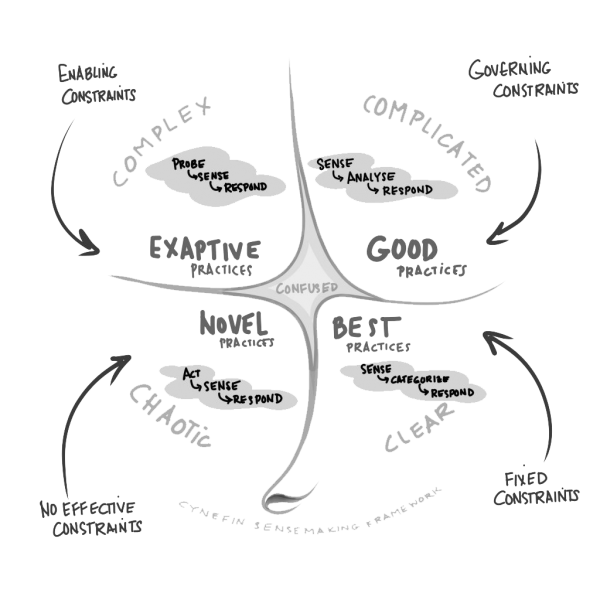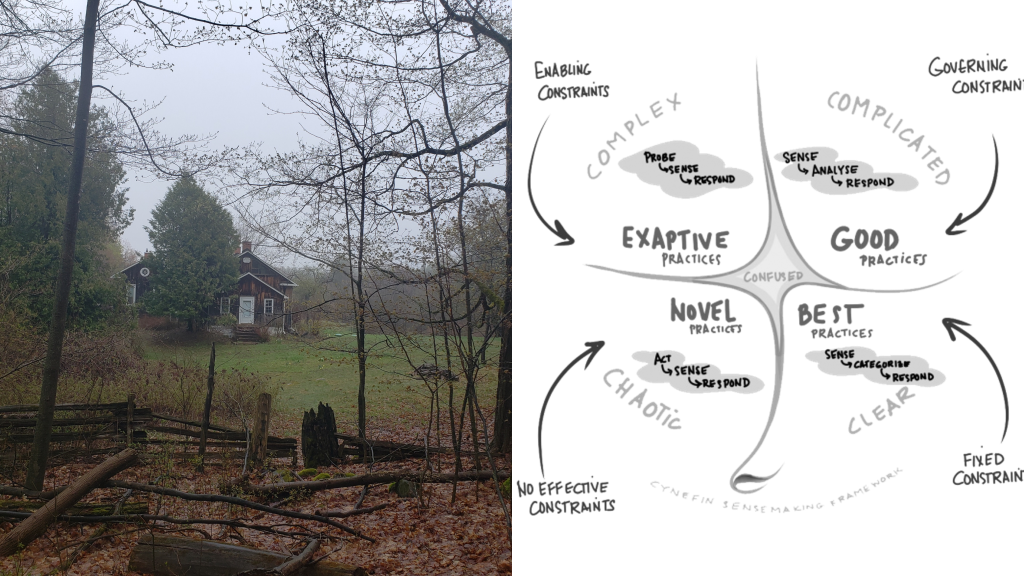
A few weeks ago I began a course called Complexity Inside Out taught by Chris Corrigan and Caitlin Frost of Harvest Moon Consultants. I have followed Chris’ blog for a few years now on the recommendation of my friend and mentor Ron and the insights he offers to those of us working with complexity and narrative should be considered a reference library or a goldmine of insight. So when I heard he was offering the CIO course, even though I’ve been working with or trained on some of the content, I jumped at the chance. For me the added bonus of the course is the recognition that working in complexity requires personal shifts in perspectives as well as those external connections. The boundaries are, after all, somewhat illusory.
Last week Chris introduced us to the Cynefin (kuh-nev-in) Framework, developed by Dave Snowden. Cynefin is a ” Welsh word that signifies the multiple, intertwined factors in our environment and our experience that influence us (how we think, interpret and act) in ways we can never fully understand.” At the heart of the model are three different kinds of contexts or ‘domains’ :
- Ordered systems in which cause and effect relationships are either clear or discoverable through analysis;
- Complex systems in which the only way to understand the system is to interact;
- Chaotic systems in which turbulence prevails and immediate stabilizing action is required.
In ordered systems best and good practices are most appropriate. When there is a Clear relationship between cause and effect, common sense prevails- you bend to tie your shoelaces if they have come undone. The relationship may become more Complicated but with some investigation an appropriate course of action can be discovered, such as solving toothache by a visit to the dentist. In ordered domains, there is a clear vision of an outcome and a direction to it. In the Complex domain however the relationship between cause and effect isn’t linear, there is lots of feedback and uncertainty and a clear outcome isn’t possible, at least in the short term. There are patterns and constraints, but we need to know more about the context by probing and sensemaking. In the chaotic domain there are no effective constraints. If this all sounds a bit hard to grasp, i recommend Chris’ blog “Experiencing Cynefin physically in a group”
The framework recognises the importance of developing actions in the context we find ourselves in. Through a process of sensemaking (gathering stories), we recognise the context (or domain) we find ourselves in, the constraints that are operating and identify appropriate courses of action.

I took a course in Cynefin from Cognitive Edge (as it was-now the Cynefin Co) iN December 2020 and while i haven’t yet used it formally (if you think it might work for you get in touch! ), its a framework I continually return to as a guide to my thinking and action in complexity.
Its a perfect framework to use following narrative techniques like Participatory Narrative Inquiry as the sensemaking tool. Stories that arise from PNI can be mapped to the framework and action can be planned dependening on the context.
I’ve been thinking in terms of the Cynefin Framework in two problem areas I’m involved with at present. The first is as a Consultant Narrative Ecologist to and Friend of The ‘Friends of the Dingle Schoolhouse (FDS)’, concerning which I wrote a blog post. While we used PNI to aid sensemaking for the FDS, we didn’t then proceed to use Cynefin, although it was certainly influencing my thoughts. Subsequently though, I can begin to see how our emerging stories mapped to the domains of Cynefin.

The principle objective for the FDS was to gain access to Rosemary Kilbourn’s Schoolhouse to deal with immediate concerns around deterioration of the property and gardens that was occuring with a resident caretaker. There was also a clear causal line in everyone’s head between the end vision of the Schoolhouse becoming an artist’s retreat and property ownership and/or occupation. We required expert advice from the TRCA and property lawyers, so these narratives were clearly constrained and resided in the ordered domain.
However, other narratives arose from the PNI that were more part of a Complex narrative: the changing role of the TRCA as its powers were limited by BIll 23, the deteriorating dam, and the diffuse nature of the wider Schoolhouse Community and its relation to landscape. As it has turned out, property ownership has currently fallen off the ledge that divides the ordered domain from chaos and so we have acted. Working from a place where the community of artists becomes the narrative focus, we are setting up an enabling constraint: writers and artists workshops using the schoolhouse and The Dingle as the muse, just as Rosemary and the “Dingle Group” did in their work.
The second area of work which will benefit from the Cynefin Framework is related to my PhD through the theme of agricultural/rural livelihoods. This week, and in February, I attended the Town Of Caledon’s Farmer’s Roundtable with the Mount Wolfe Farm Team. The Town is consulting on part of The Official Plan review involving on-farm diversified uses. Its great the Town is doing this: non-ag or ag-adjacent businesses have in the past been restricted by planning regulations, and this is a recognition of the importance of diversified use (e.g. tourism, education, wineries) to a farm’s economy.
What has become clear to me is that what the Town wants and needs is in the Obvious domain- best and good practices that can operate and be in shrined in policy and legislation for clarity and ease of operation. All well and good. However there is much about diversified uses in particular and agriculture more broadly that sits in the domain of Complexity. Issues around climate change, the environment, resilience, growth and development, equality, technology and the changing nature of society all interact with agriculture to create what’s known as a ‘wicked problem’. I will be writing more on this in future.
